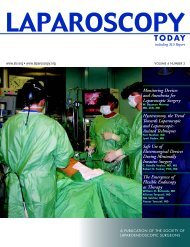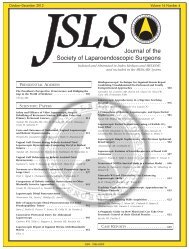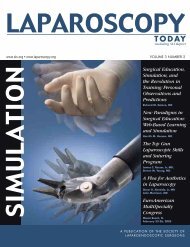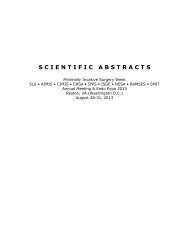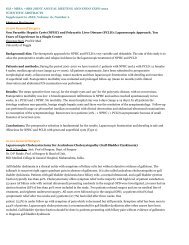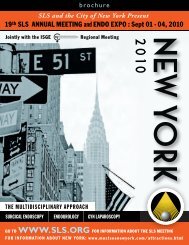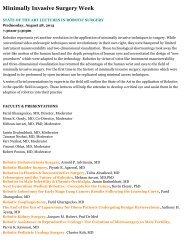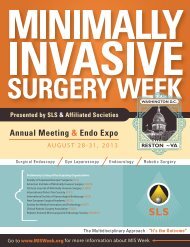Abstract/Article - Laparoscopy Today
Abstract/Article - Laparoscopy Today
Abstract/Article - Laparoscopy Today
You also want an ePaper? Increase the reach of your titles
YUMPU automatically turns print PDFs into web optimized ePapers that Google loves.
Nezhat. Video- and Robotic-assisted Surgery 239<br />
invariably fades from our memory like a fleeting aberration.<br />
Yet, when comparing surgical outcomes of today with those<br />
from just 30 years ago, we can see that the price paid was<br />
staggering, in particular for those with chronic disorders,<br />
which can require multiple surgical interventions to treat.<br />
For example, before endoscopy, female patients with<br />
chronic disorders such as endometriosis often had no choice<br />
but to undergo multiple laparotomies to treat sometimes only<br />
minimal disease. Research centers such as the World Endometriosis<br />
Research Foundation estimate that as many as 170<br />
million women worldwide have endometriosis. By this example<br />
alone, we can see that the hidden cost of our collective<br />
inertia may have adversely affected millions of lives [12].<br />
And so it was that worldwide, in all surgical disciplines,<br />
shock-inducing incisions were made in treating what sometimes<br />
were the mildest of maladies [10].<br />
‘‘Sometimes Good Things Fall Apart So That Better<br />
Things Can Fall Together’’ [Jessica Howell]<br />
Like disruptive technologies are apt to do, the introduction<br />
of endoscopy called into question nearly 2 centuries of<br />
cherished traditions, ushering in the inescapable new reality<br />
that 170 years of surgical norms were no longer optimal care<br />
and that large incisions were not only unnecessary in most<br />
cases, but they often risked causing even more chronic pain<br />
and morbidity than the original illness.<br />
After witnessing outcomes that seemed nothing short of<br />
miracles, even for notoriously difficult surgeries such as<br />
bowel, bladder, or ureter resection or reanastomosis; radical<br />
hysterectomy; advanced ovarian cancer; pelvic and paraaortic<br />
lymph node dissection; sacral colpopexy; management<br />
of ovarian remnant syndrome; and laparoscopy in<br />
advanced pregnancy, in 1990, our team could not help but<br />
proclaim that ‘‘In 20 years, major abdominal surgery will<br />
be nearly extinct.’’ Carrying on with our unabashed declaratives,<br />
we went on to state that with endoscopy ‘‘You can see<br />
better; and if you see better, you can do better,’’ noting too<br />
that ‘‘Wherever in the body a cavity exists or.can be created,<br />
laparoscopy is indicated and probably preferable.<br />
The limiting factors are skill and experience of the surgeon<br />
and the availability of proper instrumentation’’ [13–26].<br />
What we failed to foresee, however, was just how many<br />
epic academic brawls would ensue as a result of this unwelcome<br />
threat to the entire order of things [27–32]. In the<br />
early 1980s, for example, one reviewer lambasted our first<br />
manuscript to bits, declaring in no uncertain terms that<br />
‘‘The authors’ [Nezhat et al] recommendation to operate on<br />
the monitor instead of looking through the laparoscope is<br />
dangerous and irresponsible. It could lead to severe<br />
complications and death of.patients. Only 1 out of 200<br />
surgeons might be able to operate on the monitor and off<br />
the images the way Nezhat recommends’’ (personal<br />
communication). In the late 1980s, another reviewer found<br />
our first report on laparoscopic bowel resections so<br />
unconscionable that he could barely contain his ire, calling<br />
the entire enterprise ‘‘barbaric’’ (personal communication).<br />
Even after collecting years of sound clinical data<br />
[2,4,34–52], video-assisted endoscopy continued to be the<br />
subject of nearly universal derision for most of the 20th<br />
century, dismissed as a glitzy gimmick of sorts, an implausible<br />
bubble just waiting to burst into oblivion [14,53–60].<br />
The Moment of Reckoning Is Finally Here<br />
It was only after overwhelming evidence in favor of the<br />
new surgical philosophy accreted to a point where it became<br />
impossible to ignore that open surgery was finally subjected<br />
to more rigorous critical analysis, a nearly 30-year process<br />
that ultimately has led to its worldwide downfall as the criterion<br />
standard of surgery [2,13]. More remarkable, even<br />
with elderly, pediatric, obese, emergency, and oncologic<br />
patients, in whom video-assisted endoscopy had remained<br />
staunchly contraindicated for most of the 20th century,<br />
a breathtaking reversal has occurred as physicians in these<br />
fields are now beseeching their colleagues to phase out<br />
overreliance on large incisions and embrace video-assisted<br />
endoscopy as their criterion standard of choice [2,13,61–65].<br />
Even the most advanced laparoscopic procedures, those<br />
referred to as imprudent and infeasible for most of the<br />
20th century [66], are now considered so superior to laparotomy<br />
that the New England Journal of Medicine dedicated an<br />
entire editorial on the subject, noting that ‘‘Technological<br />
advances, which are followed by long periods of catch-up<br />
while clinicians learn how to use the new techniques appropriately,<br />
often precede true medical progress. Early on, surgeons<br />
were hampered by having to steady the laparoscope<br />
with one hand and look through a small lens while performing<br />
surgery with the other hand. Advances in laparoscopic<br />
surgery were facilitated by a series of innovations that allow<br />
true video surgery, in which two surgeons work together<br />
with both hands to perform operations. Surgeons must<br />
progress beyond the traditional techniques of cutting and<br />
sewing., to a future in which.minimal access to the<br />
abdominal cavity [is] only the beginning’’ [59]. How ironic<br />
that the procedure of laparoscopic colectomy referenced in<br />
this editorial, the same one first presented at the American<br />
Fertility Society in 1988, was the very procedure referred<br />
to as ‘‘barbaric’’ just a few years ago [29,31,33,67,68].<br />
Critical Reappraisal<br />
Perhaps of greatest significance, the introduction of minimally<br />
invasive surgery is catalyzing a long-overdue moment<br />
of reckoning, when all surgical traditions are finally being<br />
held to the light of scrutiny. For example, with the new minimally<br />
invasive philosophy leading the way, emphasis on<br />
sparing reproductive organs is becoming the norm in gynecology,<br />
rather than the exception. Another profound effect<br />
has been the way video-assisted endoscopy has revolutionized<br />
our understanding of anatomy. Just through these new




